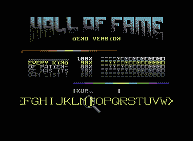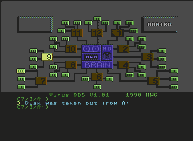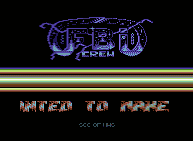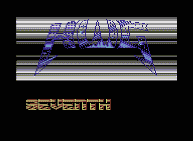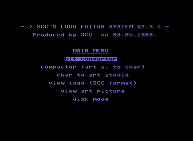In 1990 we had been coding intros, demos and cracks for almost two years. The local duel with BCB and HSA was over, writing demos seemed a bit pointless. So, many of the things we learned were put into two games. "Solitaire" is one of the earliest computer implementation of solitaire games, and that makes me feel good.
Solitaire is my major product. I finished it in 1991. That is the age without illegal opcodes, yet. It's 100% pure 6510 code ;).
My first encounter with solitaires took place during the mid-eighties. Around 1989 I saw a PC implementation of Klondike (named Las Vegas). It was a pretty simple, character-based program. It was obvious that our demo-coding experience was there to help us code a nice solitaire game.
Solitaire is completely my design. But it wasn't my only goal to write a game... to write an amazing one, that was what I wanted to do. Later I participated in a program contest with Solitaire, unfortunately I screwed up the presentation to the Jury and ended up in third place. I even tried to sell this game to a software house in Holland. I found the name and address of the contact person in a Hungarian Commodore magazine. The guy wasn't working for the company anymore when I sent him the demo version... That's my luck. (Later I wrote games for Windows as well.)
The game has an auto-start routine, and the directory is modified to trick the curious user. Just try to load any files from the disk (the ordinary way). A turbo loader was added as well.
- Intro. The entire intro was coded by me. The logo and the character sets are mine as well. These ten colors I used here have an influence all over the other parts of the game, the user will know that it's the same product. The intro music was composed by Teonaki. The border take-offs were quite common for us those days.
- Menu. The menu of Solitaire presents the same ten colors used in the intro. No technical brilliance here, just some nice graphics.
- Rules. Again, those ten colors are used in the small logo and the raster bars. The rules are displayed in the bottom half of the screen while in the upper half the name and difficulty of the selected solitaire are displayed. In the four corners of the screen you can see the suit symbols, of course, "under" the border.
- Game Play. All three games have different game plays. The common features are the pointer arrow and the time counter (both in the borders). The game is played by joystick, the "N" key for next and the "F" key for foundation are also used. Sound effects are Teonaki's.
- Hall of Fame. Again the same colors in the design. And that convex lens. It's just a nice little routine from the last part of my Big Logo Disk. The 2x2 char-set is made by Crazy Speed, music by Teonaki.
Download
- Full Version: The full version of Solitaire. (174 848 bytes)
Autoloader, start with LOAD":*",8,8 - Demo Version: The limited edition of Solitaire. (174 848 bytes)
Start with LOAD":*",8,8
Hall of Fame: LOAD"HALL*",8,8 - Full Version (Cracked Tape Edition): The full version of Solitaire cracked by Triad. (174 848 bytes).
Music
- Main Theme 2023 KBytes, MP3, 44.1 kHz, 16 bit, 96 KBps, Mono
- Hall of Fame Theme 1063 KBytes, MP3, 44.1 kHz, 16 bit, 96 KBps, Mono
All screen shots presented here contain the whole screen area (or even more), the borders are always included. Of course there're some border take-offs... Captured using CCS64 and its Use PAL Palette mode.








